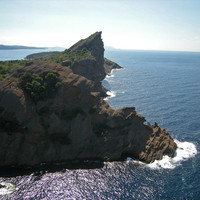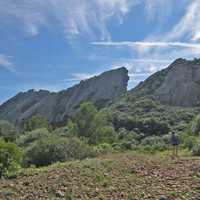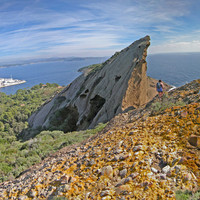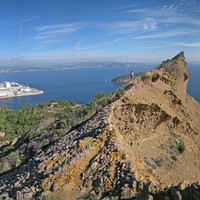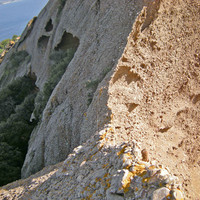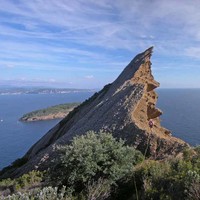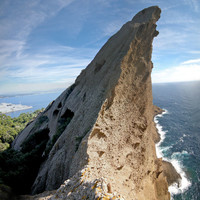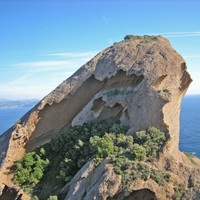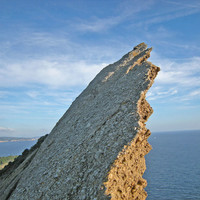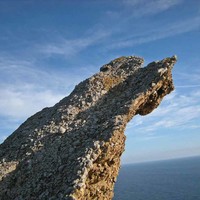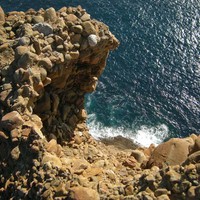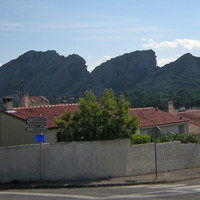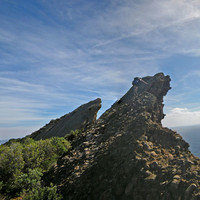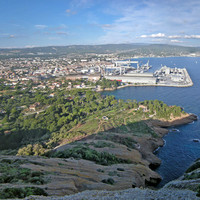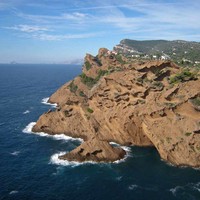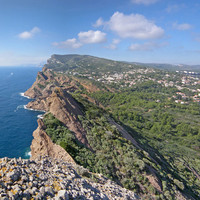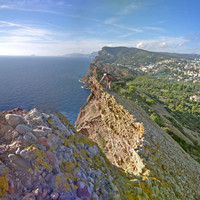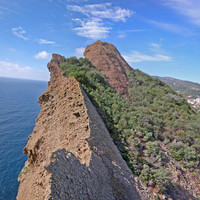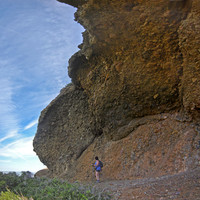Bec de l'Aigle (la Ciotat) : W-ridge traverse
Fusionner des documents
Attention, les photos associées ne seront pas supprimées et deviendront orphelines.
Si vous souhaitez juste modifier le titre ou les documents associés (ex : déplacer une sortie vers un autre itinéraire), il suffit de modifier le document.
Si ce document est un doublon comportant des photos, demandez @Modo_Topo_FR de fusionner les doublons pour déplacer les photos sur le document conservé.
Livres
Itinéraires
Articles
Images
Rapports incidents/accidents
Exciting traverse above the Sea and over the four high points of the spectacular Bec de l'Aigle.
- Exposure as much as each climber wants to choose (how close to the south edge of the ridge/arete you go).
- Easy access from the city of La Ciotat.
- Rock is puddingstone with abundant positive holds.
- Difficulty is mostly grade 2 or less, with one sustained harder section.
- Dangerous breakable and loose rock in at least one section.
. . . (partly avoidable by exiting early from the traverse).
Description
statistics:
. uphill walking + climbing vertical: +200 m
. length of climbing at difficulty 2 or higher: 100-250 m
. horizontal distance of ascent: 1.0 km
. horizontal distance of normal descent NW face + return to start: 1.5 km
approach:
From the entry to Anse de Figuerolles (GPS latitude/longitude ~ N43.1674 E5.5987), go ESE on the city street for about 140m, then (at ~ N43.16700 E5.60037) turn Right onto Avenue des Myrtilles and go 10m to the end of the street - (this point could also be reached from the Mugel parking), then start climbing up on a firefighters road (dirt) and go S about 250m. Bear Right off the firefighters road onto a dirt trail and continue up S about another 50m, then SW about 30m up to a viewpoint at the top of puddingstone hump (lat/long ~ N43.1638 E5.5996), roughly the SW corner of the top of the cliffs. Look ESE to see the West arete/ridge rising up.
traverse from west end to col Belvedere:
Hike up ESE toward the rock of the arete/ridge for about 40m to a bolt with blue paint, then up another 10m to a flat section under a big overhang. Traverse Left around N end of overhang (Variation: Instead traversing R has more interesting climbing around 4b, but the rock that way is very loose). Then SE on rock about 60m up to the West summit (N43.1631 E5.6007).
Down for about 50m to the first col, steep on both sides. Climb arete over col (or traverse high across the N side of the col), then a thoughtful step (3a) across onto the face to its left. Next about 25m climbing (difficulty 2+ exposed) - (more exciting if stay near R edge) up to 2-bolt anchor, then another 15-20m easier up to the Mid-West summit (N43.1626 E5.6016). Continue ESE down along the ridge about 100m to reach the second col, the Belvedere (N43.1621 E5.6029), with concrete walls. Look E and up to see the crux steep section.
. . (Escape: There is an obvious well-maintained walking trail NE from the Belvedere col down and out about 0.6 km to the entry gate of Parc du Mugel).
traverse from col Belvedere to East summit:
Hike + scramble NE, passing left below a small rock tower, up to the base of the crux section.
This crux section above E from col Belvedere is tricky because it has both more difficult climbing and more breakable and/or loose rock, dangerous both to the climber and to anyone below. For much more detail, see further below "crux section problems + strategies" below under Remarks.
. . . (If have any doubt about handling this, just end this traverse below at col Belvedere and walk out easily down the trail).
Directly up the face toward the S (R) side of roof is steeper than what has come before. Difficulty around 3a, lacking good protection (as of 2017), and with exposure. Perhaps easier in the upper half to go a bit Left (on rock perhaps more breakable) into the obvious cave under a roof, then traverse back Right (loose rock) to get around the roof (easier climbing than below, but very exposed). Soon reach 2-bolt anchor (as of 2015) above - (pitch of 25m-30m) . ((No intermediate protection hardware as of 2019, and with minimal or no opportunites for protection with Trad gear).
Variation Left: After scrambling up to under the cave and roof, instead walk farther Left to the base of ramp, then up the ramp (much less steep than the direct face) with loose rock up into the cave, then continue across the cave (? might be protection by placing a very long sling around a rock horn ?), then avoid the roof by exiting the right end of the cave (very exposed, but likely not as difficult as the direct face of the Main Route), and up to the 2-bolt anchor.
Variation Right (longer and plenty exposed, but not harder, perhaps more sound rock): Partway up the face toward the cave, near a small pod, instead stay away from the cave by aiming right-ward to follow a ramp up around right to near its top, then aim a bit left and up to the summit. No anchor bolts, but rock horns available above the steeper climbing.
Above the 2-bolt anchor, continue up 40m easier to the Mid-East summit (N43.1619 E5.6039).
From the Mid-East summit, go down easily a short ways to a third col (which is also on the NW face route). Finally continue ESE upward on dramatic arete, then roughly horizontal to the East (highest) summit (N43.1612 E5.6055).
descent:
Return WNW to the third col, and use the NW face route to go down then out to the Parc du Mugel entry gate (N43.1654 E5.6061) - (locked at night, often even before dark). From there go roughly N on a street for about 200m, then turn left onto Avenue du Mugel and go W about 500m. Turn L onto Avenue des Myrtilles, S about 130m down + up -- to reach the start of the firefighters road. From there can go West about 140m to the Anse de Figuerolles entry.
Variation (West + East integrale): Instead of descending NW, continue E over the summit, then down-climb the ENE face all the way to edge of the Sea, and return along the Sea (at first NW, later NE) to the Parc entry gate by reversing the start of the Traversee Parpeles route.
Remarques
Nice to use all or part of this route in combination with the Traversée des Parpèles seacoast tour of the Bec de l'Aigle.
Breakable + loose rock: It's not unusual for pieces of puddingstone rock to break off.
Locked gate: The entry gate for Parc du Mugel is locked at night, often even before darkness. The hours of closure are different at different seasons of the year, so check in advance, or you might find yourself with no easy exit after successfully traversing the arete/ridge.
crux section problems + strategies:
The section above E from col Belvedere is tricky because it has both more difficult climbing and more breakable and/or loose rock, dangerous both to the climber and to anyone below. Further tricky because it is difficult to both be careful to test for breakable rock and work out more difficult climbing moves at the same time, and in the emotional context of exposure to a substantial fall.
Much of the worst rock is near or in the obvious cave, so one key guideline is that no one be anywhere near under the cave while anyone else is climbing near or in it -- instead wait on the main Belvedere platform for the walkers.
Another key guideline is that each person should either stay well away from the cave, or be especially careful testing for loose rock while climbing near or in the cave. This gets tricky because at least one section of the climbing appears to be easier by going near or in the cave -- and this section comes when feeling exposed (perhaps also tired) above more difficult climbing, so not feeling comfortable to go back down, and also not wishing to take on additional difficult climbing (away from the cave) even higher more exposed.
Possible strategies:
(a) Safest is to exit NE down the walking trail. Perhaps then climb to the East or Mid-East summit by the normal route (extra uphill work, but less dangerous and difficult). Or since those summits are not much different or better than what has come so far, just declare the traverse to be finished and walk out the entry gate - (especially if already completed the Traversee Parpeles before starting the West Ridge, continuing further east along the ridge adds little).
(b) One climber with the leading end of the rope goes up past the cave (by whichever route seems safest considering both difficulty and breakable rock) and continues on to the 2-bolt anchor (as of 2014) higher above -- all with minimal or no protection. Perhaps connect the low end of the rope to some bush near the bottom of the crux section so the following climbers can easily reach it.
If the leader wants to have normal belaying, the belayer must be positioned way far from under the climbing leader or the cave, to avoid getting hit by a falling rock. This likely requires a much longer rope and managing dragging of the rope. Or the low end of the rope could be tied to something at the bottom, and the leader use some rope-solo lead self-belay system. Or since there's at best minimal protection anyway (as of 2017), the leader could simply ciimb it all solo with no belay.
Then each following climber can tie to the rope and then climb with belay from above (with the others still below waiting far away) and climb the main route directly up past near the right end of the cave.
(c) Multiple persons climb together using the Variation Left, staying close together so the impact a breaking or falling rock is less, into the cave and then continue on past it up to the anchor above -- all with minimal or no protection.
Matériel
30 meter rope
3 quick-draws
loops of slings/runners to wrap around rock horns
Accès en transport en commun
Arrêt : Haute Bertrandière (La Ciotat)
Distance avec le point d'arrêt du topo : 0.52 km
Voir le détail des lignes
Arrêt : Le Pré (La Ciotat)
Distance avec le point d'arrêt du topo : 0.91 km
Voir le détail des lignes
Arrêt : Chantiers Navals (La Ciotat)
Distance avec le point d'arrêt du topo : 0.96 km
Voir le détail des lignes
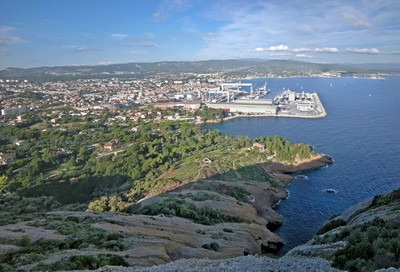
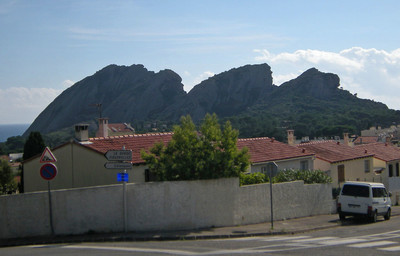
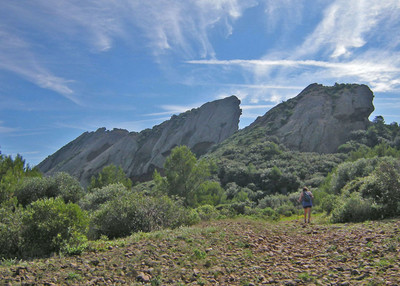
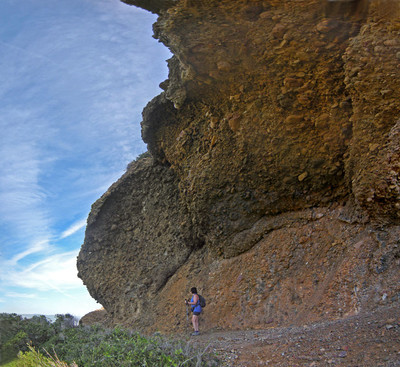
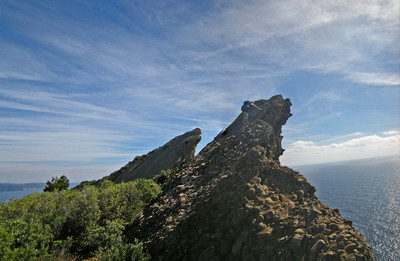
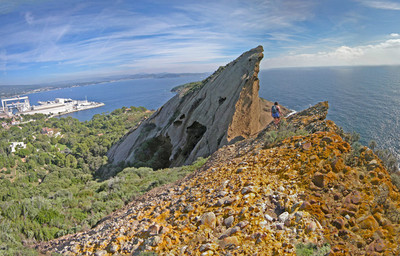
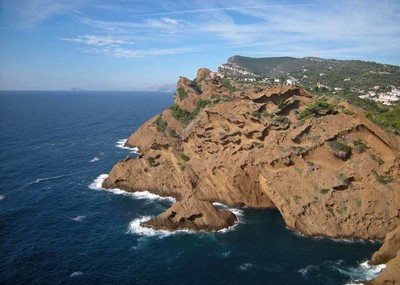
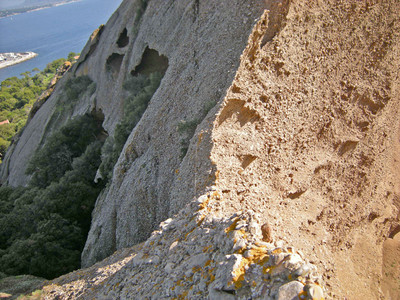
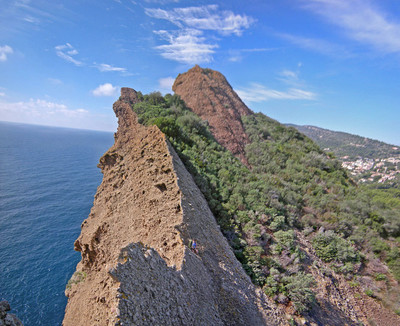
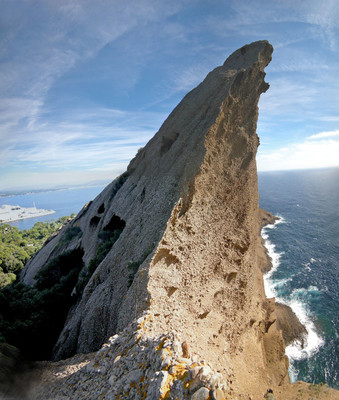
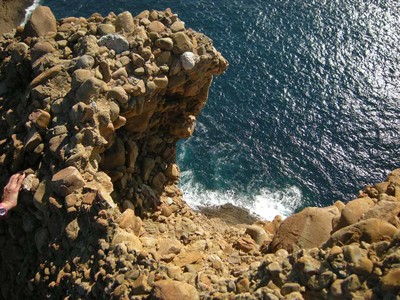
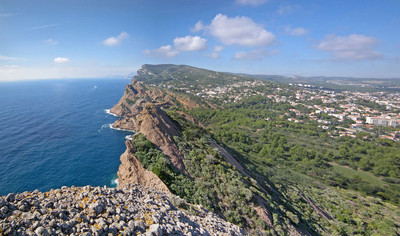
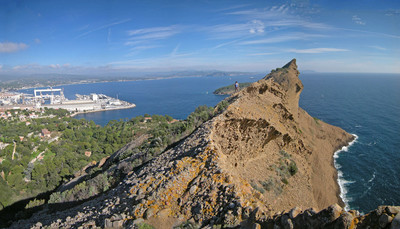
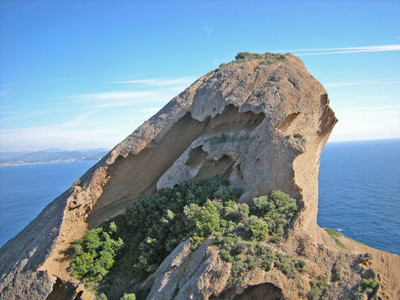
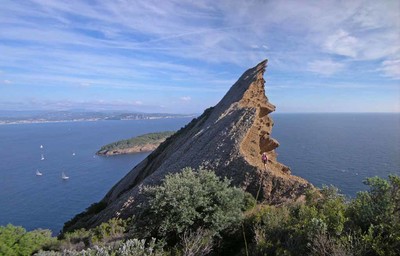
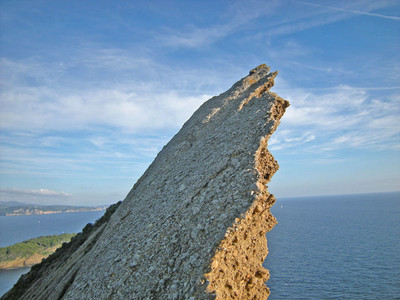
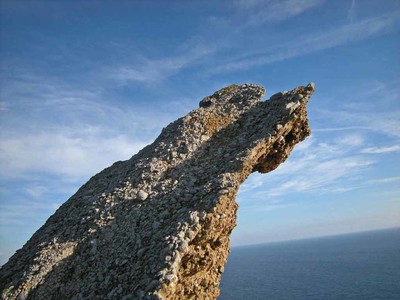
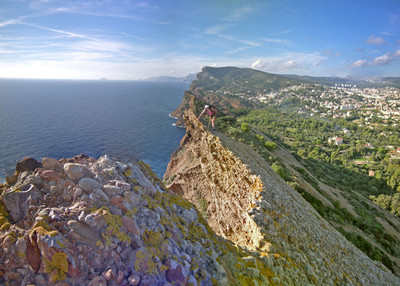
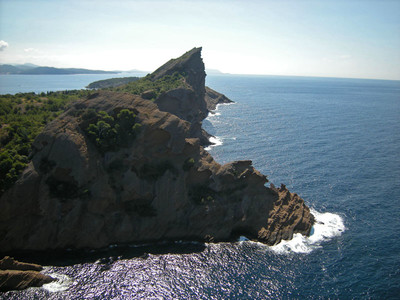
Commentaires
Ce contenu est sous licence Creative Commons BY-SA 3.0
Les images associées à cette page sont disponibles sous la licence spécifiée sur le document d'origine de chaque image.
Imprimé le 23 novembre 2025 01:46


